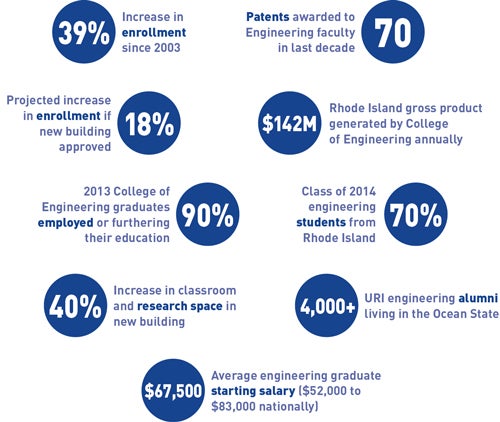Engineering the Future
 While the Rhode Island General Assembly’s spring 2014 passage of a $125-million bond initiative for engineering was excellent news for URI, it’s not a done deal. Rhode Islanders must still “Vote Yes on 4.” Here’s why we think you should.
While the Rhode Island General Assembly’s spring 2014 passage of a $125-million bond initiative for engineering was excellent news for URI, it’s not a done deal. Rhode Islanders must still “Vote Yes on 4.” Here’s why we think you should.
Let’s say you graduated from URI 50 years ago, in 1964, with a degree in mechanical engineering. And let’s say you had not been back to campus until your 50th reunion, this past May.
You would probably be surprised to see that the classrooms and the laboratories where you spent so many hours appeared almost unchanged. You might even wonder if the Engineering Quad had been specially preserved as a kind of tribute to the faculty and students of days gone by.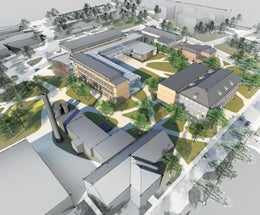 The good news is that when you return for your 55th reunion in 2019, the University hopes you will find a new, state-of-the-art College of Engineering facility. There is only one more hurdle to leap before ground can be broken on a building that will bring together seven of the University’s eight engineering disciplines in one spectacular space, and transform the way engineering is taught.
The good news is that when you return for your 55th reunion in 2019, the University hopes you will find a new, state-of-the-art College of Engineering facility. There is only one more hurdle to leap before ground can be broken on a building that will bring together seven of the University’s eight engineering disciplines in one spectacular space, and transform the way engineering is taught.
On November 4, Rhode Island voters—including many readers ofQuadAngles—will weigh in on what the General Assembly has already endorsed: a $125-million bond for URI’s new engineering facility. Passage of this historic bond initiative will allow the University to upgrade outdated classrooms and laboratories to match the outstanding caliber of teaching, research, innovation, and discovery at the College of Engineering.
A major force behind the change is Dean of the College of Engineering Raymond Wright. He’s quick to cite examples of how engineers have changed the course of history. “What one thing, if you leave it at home, would you go back for?” he asks a visitor. “Your phone!” It is no secret that most major technological changes in our history have involved engineers. “Innovation is what we teach here,” Wright says.
NUWC and URI: A Productive Partnership
“The Naval Undersea War Center is the place to go if you like underwater technology,” says Dean Emeritus Thomas Kim, who has spent the last 21 years as director of NUWC’s internship program, forging connections with military personnel and Navy officials and advising students.
Each year more than 300 applicants from around the country apply for a coveted spot. After careful review by Kim, his staff and the Navy, 30 to 80 earn internships. Once on the base, interns find themselves immersed in crafting technology for America’s next-generation warships and submarines.
Six years ago, the Navy tasked intern Akinyemi “Yemi” Akinsinde ’08 M.S.’11, now an engineer at the base, with reducing drag on torpedoes. For a URI college senior more accustomed to classrooms, the Navy’s lab outfitted with water tanks and advanced instrumentation proved an engineer’s playground.
“It was fun,” he says. “After classes at URI I would just drive down here and lose myself in this building.”
It was exactly the kind of experience Kim envisioned when he bid on the Navy contract.
The dean’s career has arced from electrical to mechanical and finally, here at URI, civil engineering, with a specialty in surface water systems, wet weather pollutant sources and their impact on receiving waters, and storm-water monitoring and modeling. Bliss Hall has been his home for his entire 33-year URI career. As he energetically describes what will be a transformational moment in the history of the College, he uses a model resting on a conference table in Bliss to point out the finer details of the proposed complex, and explains that upon its completion, Bliss will serve as the gateway to the new facility.
This past academic year has been unique for Wright, the first time he has not taught. For a man who loves interacting with students, and especially “bringing the experience of the real world into the classroom,” not teaching was tough. Ramping up the bond initiative was Wright’s top priority. In fact, it has become a matter of urgency for URI.
Provost Donald DeHayes boils it down to this: “Our engineering programs are outstanding. We hear this from students, from faculty, and from the employers who hire our graduates year after year. Our facilities, however, are substantially out of date and limit both teaching and research.”
The November 4 referendum will determine the outcome of a seven-year journey that began when Wright was appointed interim dean. His first step was a thorough evaluation of engineering programs, identifying key research themes that leveraged existing strengths, including the natural collaborations among disciplines that had been bubbling up for years. The only boundary became engineering—not the narrower, constricting boundaries of the specific disciplines.
How can structures that were built between 1958 and 1962 to accommodate 400 engineering students evolve to match this new multidisciplinary subject, and the 1,500 students who come here to study it? Wright concedes it’s a difficult proposition; the second leg of the College’s journey focused on facilities.
Ballinger, of Philadelphia, was one of the first firms in the country to merge architecture and engineering into a professional practice. Major research institutions across the country have hired the firm to develop creative solutions to space challenges on their campuses.
Ballinger conducted a comprehensive review of each of URI’s current engineering structures to determine their value. The firm concluded that many of the buildings, which were mostly designed as classroom space, are not appropriate for the engineering of today and the future.
“We don’t have enough circuit breakers to support our experiments,” Wright says, “let alone a nanofabrication cleanroom.”
Kirk will be renovated, but Ballinger’s analysis indicates other buildings on the Engineering Quadrangle—the flat-roofed cinderblock structures currently bursting at the seams with students and equipment they weren’t built to hold—can’t be cost-effectively renovated. They’ll be replaced by a new, state-of-the-art, 195,000-square-foot teaching and research facility near Bliss, including a planned “Capstone and Corporate Engineering” wing where students and researchers can tackle real-world problems alongside corporate partners.
The dean pauses for a moment. “It’s actually amazing—a testament to our programs—that we are as successful as we are in attracting great students. Enrollment is high. The academic index of our entering students is as high as it’s ever been. There are good reasons why students come here—we give them great traditional engineering programs like electrical, civil, and mechanical, plus unique programs like pharmaceutical, chemical, biomedical, and ocean engineering, which is one of only eight in the entire country. Our student-to-student mentoring program is unrivaled. The International Engineering Program is 27 years strong and remains one of the most innovative programs in the country, the expression of our vision of the global engineer: multilingual, multicultural, and highly adaptable.”
The proof, of course, is in the hiring—and when they graduate, engineering majors get jobs. More than 750 Rhode Island companies employ URI engineering alumni. A lever for hiring is the College’s year-long Capstone Project. Representatives of participating companies serve as mentors. They ask open-ended questions of teams of seniors, who are charged with developing, and formally presenting, real-world solutions to real-world problems. Richard Schloesser, former president and CEO of Toray Plastics (America), says the program “has been a boon for Toray’s professional pipeline. We have hired people on the spot after hearing their presentations.”
Another top employer for budding URI engineers is the Naval Undersea Warfare Center (NUWC) in Newport, R.I., where the U.S. Navy develops its most advanced and classified underwater technologies. The College won a little-known contract with the Navy that placed URI in charge of recruiting and screening students from around the country for paid internships there. Well over one thousand URI students have participated in the program, and one in four engineers at the warfare center hold a URI degree.
Wright points out that for the Navy, as for businesses, a strong workforce requires a constant flow of new minds. “When I meet CEOs and presidents of companies, I ask what the College can do for them,” he says. For the last seven years, he has reviewed the résumés of every graduating engineer. He is proud to note that 85 percent have had at least one engineering internship: “The companies come back every year. They are confident in our students’ abilities.”
So, in fact, is there a crisis? Are new facilities needed?Ballinger’s Terry Steelman, who has worked on similar projects across the country, says the answer is an unequivocal yes. “URI is at a crossroads now. The College cannot just maintain these facilities or you will lose ground. In order to advance, be cutting-edge, you have to build.”
Wright explains that teaching and research requirements have changed drastically over the decades. “Everything is more collaborative now. The best student experience comes when classroom and lab combine. Our current facilities simply don’t allow that.”
The moment this became crystal clear was when two relatively new faculty members came to Wright within weeks of each other and said they were leaving for institutions with greater capacity and more advanced laboratory facilities. “Faculty do come here from much better resourced schools with much better labs,” he says. Wright is all too aware, however, that after their start-up packages end—typically after three years—many young faculty feel their professional development is restricted by URI’s facilities. And then it is difficult to resist offers from institutions where their growth trajectory is clear.
The third leg of the journey, then, after the bond passes and the facilities are built, will be to raise an additional $25 to $30 million for competitive start-up packages to attract young faculty to URI—and keep them. This “future fund” will also pay for core laboratories and research equipment.
Toray has already pledged $2 million toward the proposed construction of the new facilities with an eye to helping URI attract the highest caliber engineering candidates. Wright is grateful: “Parents comment all the time that other schools they visit are far ahead of URI in terms of facilities. The promise of the new complex will go a long way toward convincing parents that their students will thrive at URI.”
Ever optimistic, Wright is already looking ahead to 2019, when he hopes the building will be completed. “What gets me up in the morning?” he asks. “When I retire as dean, I hope this building will be done. Then I can look ahead and see where engineering will grow for the next 50 years.”
That done, the dean says, “I can go back to teaching.”
—Melanie Coon
Arun Shukla: Explosive Talent
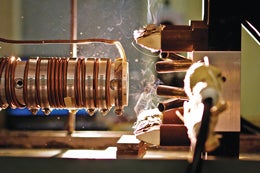 Most engineers try to keep things together. Shukla, a professor of Mechanical Engineering, breaks them apart. He shoots bullets, sets off blasts and strikes things with mighty force in the name of science.
Most engineers try to keep things together. Shukla, a professor of Mechanical Engineering, breaks them apart. He shoots bullets, sets off blasts and strikes things with mighty force in the name of science.
For 26 years, Shukla has operated a lab at the University of Rhode Island that tests how materials fracture under unusual circumstances. His extreme research brings national acclaim: He has appeared on the Discovery Channel and NBC’s nationally broadcast Today Show. Reporters turn to him to explain bridge collapses, and generals ask him to find better ways to defend against bullets and bombs.
With space at a premium when he arrived at URI, Shukla found himself setting up a laboratory in the attic of Bliss Hall, where hammocks and mini-fridges implied another use. But three years later, when visiting Air Force officers toured his one-room lab, they liked what they saw. Grants soon followed, enabling the facility to move and expand to three rooms. Over the years, his lab has produced more than 300 research papers, at least nine university professors, and more than 80 graduate students.
Today, Shukla, who is routinely recruited by other institutions but is committed to URI and Rhode Island, says: “We struggle for additional electrical outlets. Often the power cuts out in the lab.” That constrains research dollars raised and the number of students served. “To do modern research,” he adds, “we need modern labs.”
Alfred Rodriguez ’12 M.S ’14: Inspiring Journey
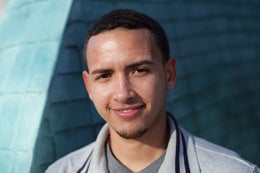 Sent from the Dominican Republic by his mother to live with relatives in Rhode Island, Rodriguez repeated the ninth grade due to language barriers. Yet, he went on to graduate as valedictorian of the Providence Academy of International Studies and was admitted to URI, where he started in the Talent Development Program before entering the College of Engineering.
Sent from the Dominican Republic by his mother to live with relatives in Rhode Island, Rodriguez repeated the ninth grade due to language barriers. Yet, he went on to graduate as valedictorian of the Providence Academy of International Studies and was admitted to URI, where he started in the Talent Development Program before entering the College of Engineering.
Charles “Chuck” Watson, who heads up minority recruitment and retention for the College, was with Rodriguez every step of the way—from freshman year struggles, when Rodriguez questioned his ability to compete at URI, through a transformation that saw him rise through the ranks of the Society of Hispanic Professional Engineers (SHPE), which he eventually served as president. Watson says the key for Rodriguez was a network of support that included the URI Engineering fraternity, SHPE, peer mentoring, and the “earning and learning” program that funds undergraduates to work alongside graduate students and faculty in labs.
After interning at Gilbane, Inc. and graduating magna cum laude, Rodriguez landed a full-time job there. This year, he earned his master’s from URI.
Rodriguez’ trajectory is a testament to URI’s integrated approach to mentoring, academic support, and professional development, Watson says—and a new facility would help create more opportunities for students like him.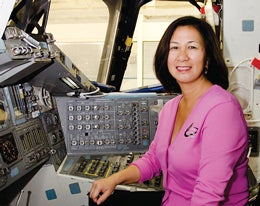 Dorothy Rasco ’81:The Final Frontier
Dorothy Rasco ’81:The Final Frontier
When the last space shuttle landed on July 21, 2011, the job for civil engineering alumna Rasco began. Rasco, NASA’s deputy associate administrator for space technology, headed the agency’s Space Shuttle Transition and Retirement Office, overseeing the orderly, two-year wind-down of the country’s space shuttle program while ensuring that work on the next-generation space program advances.
Rasco says she leaned on her URI engineering degree every step of the way in leading her team of 1,200 engineers, rocket scientists, lawyers, contract specialists, environmental experts and security personnel. “To be a successful engineer you have to be able to communicate,” she says. “You need to understand the basics that you learn from college from professors and textbooks, but it is also about being able to articulate the requirements. I think URI gave me that ability.”
Rasco began at NASA in 1985, first as an engineer designing physical facilities. She later ran a division that outfitted the space shuttle’s mid-deck cabin before serving as business manager for the entire space shuttle program. Leading the two-year, $400-million project brought her NASA career full circle.
“I am proud to say I am a shuttle hugger,” she says. “These are my babies and are national assets to the country.”
 Home
Home Browse
Browse Close
Close Events
Events Maps
Maps Email
Email Brightspace
Brightspace eCampus
eCampus



